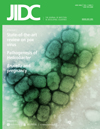Detection of Helicobacter pylori in stool specimens: comparative evaluation of nested PCR and antigen detection
DOI:
https://doi.org/10.3855/jidc.264Keywords:
H. pylori, HpSA, Stool PCR, Biopsy PCR, RUT, hspAbstract
Background: Efficacy of Helicobacter pylori stool antigen enzyme immunoassay (HpSA) and stool PCR was evaluated, before and after treatment, in a country with a high prevalence of H. pylori infection. Methodology: A total of 52 patients with dyspeptic symptoms were included in the study. Antral biopsy was collected during pre- and post-therapy periods for rapid urease test (RUT) and PCR. Similarly stool specimens for PCR and HpSA test were collected during both the periods from all 52 patients. Biopsy, PCR and RUT results together were considered the "gold standard." Results: On the basis of gold standard tests, 40/52 patients were H. pylori positive. The sensitivity and specificity of HpSA test were 80% and 83.3% respectively in untreated patients. On the other hand, the sensitivity and specificity of stool PCR in untreated patients were 72.5% and 100% respectively. After eradication therapy, the results of both RUT and biopsy PCR were negative in 87.5% and positive in 12.5% of the patients. Although post treatment sensitivity of HpSA and stool PCR was equal (60%), specificity of HpSA and stool PCR were 68.6% and 97.1% respectively. Conclusion: The H. pylori stool tests represent a non-invasive concept for diagnosis of infection. Both HpSA and stool PCR seem to be satisfactory tests for pre-eradication as well as assessment of infection. But stool PCR is a better indicator than HpSA test in the post-eradication assessment of infection.Downloads
Published
2008-06-01
How to Cite
1.
Mishra S, Singh V, Rao G, Jain AK, Dixit VK, Gulati AK, Nath G (2008) Detection of Helicobacter pylori in stool specimens: comparative evaluation of nested PCR and antigen detection. J Infect Dev Ctries 2:206–210. doi: 10.3855/jidc.264
Issue
Section
Original Articles
License
Authors who publish with this journal agree to the following terms:
- Authors retain copyright and grant the journal right of first publication with the work simultaneously licensed under a Creative Commons Attribution License that allows others to share the work with an acknowledgement of the work's authorship and initial publication in this journal.
- Authors are able to enter into separate, additional contractual arrangements for the non-exclusive distribution of the journal's published version of the work (e.g., post it to an institutional repository or publish it in a book), with an acknowledgement of its initial publication in this journal.
- Authors are permitted and encouraged to post their work online (e.g., in institutional repositories or on their website) prior to and during the submission process, as it can lead to productive exchanges, as well as earlier and greater citation of published work (See The Effect of Open Access).








